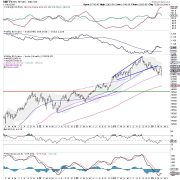It must be frustrating to be an economist. Theoretical discussions and arguments about tariffs date back to at least the eighteenth century. In 1776, Adam Smith, in The Wealth of Nations, argued against mercantilist policies, advocating for free trade and cautioning against retaliatory tariffs. He contended that such measures often lead to economic inefficiencies and harm all parties involved. In The Wealth of Nations, he acknowledged that retaliatory tariffs might sometimes lead to the quid pro quo reduction of foreign tariffs, but he was cautious — skeptical:
There may be good policy in retaliations of this kind, when there is a probability that they will procure the repeal of the high duties or prohibitions complained of. […] When there is no probability that any such repeal can be procured, it seems a bad method of compensating the injury done to certain classes of our people [by doing]…another injury ourselves, not only to those classes, but to almost all the other classes of them.
Later economists reinforced and enlarged Adam Smith’s foundational critique of retaliatory tariffs, contributing to a nuanced understanding of the complexities of international trade and the importance of maintaining open markets. (More nuanced than President Trump’s “They treat us horribly.”)
In the nineteenth century, John Stuart Mill, utilitarian philosopher and economist, acknowledged, like Smith, that while tariffs could theoretically improve a nation’s terms of trade, they more frequently exacerbated international tensions and economic inefficiencies. Imposing tariffs to manipulate trade terms provoked further retaliatory measures from other nations — and trade wars detrimental to all parties.
Recent Developments: Tariffs Imposed
On February 1, 2025, President Trump signed executive orders imposing a 25 percent tariff on all imports from Mexico and Canada and a 10 percent tariff on imports from China — effective March 4, 2025. They take aim at illegal immigration, drug trafficking, and trade imbalances. Almost immediately, President Trump delayed implementing the tariffs in favor of negotiations, seeking a series of concessions from both Canada and Mexico. His administration sought better terms on trade imbalances, particularly in the automotive and agricultural sectors, and to pressure these nations into adopting stricter policies on Chinese imports being rerouted through their markets. After weeks of talks, however, President Trump in a speech to Congress on March 5 said responses from Canada and Mexico had fallen short of his expectations; the tariffs would go into effect immediately.
On April 2, 2025, President Trump made a “Declaration of Economic Independence” during a Rose Garden address, unveiling a comprehensive overhaul of US tariff policy. The new measures introduce a universal baseline tariff of 10 percent on all imports, effective April 5, 2025, aiming to bolster domestic manufacturing and address longstanding trade imbalances. Additionally, the administration announced higher “reciprocal” tariffs on countries with significant trade surpluses or those imposing substantial duties on US goods.
The president held up a chart comparing the tariffs imposed by major trading partners on US goods, along with instances of currency manipulation used to undercut American exports. He cited China’s long-standing 68-percent average tariff on US autos, Vietnam’s 92-percent tariff on certain agricultural products, and the European Union’s 35-percent duty on American tech goods. He declared that under his new policy, the United States would respond with “reciprocal tariffs” — set at half the level of what those countries charge the US. Thus, China faces a 34 percent tariff, Vietnam 46 percent, and the EU 17.5 percent on corresponding imports. Furthermore, a 25 percent tariff on all foreign-made automobiles began April 3, 2025. President Trump emphasized that these actions are designed to protect American industries and reduce the national debt, asserting that the tariffs would generate substantial revenue to achieve these goals. “We’re not asking for fairness,” Trump said, “we’re demanding half as much unfairness as we’ve been getting.”
It is fair, I think, to say that the media, especially the financial press, had been anticipating the announcement with stories, interviews, and panel discussions that almost without exception predicted dire results of the President’s policy, whatever the details. The warnings dominated comment on U.S. markets. Few readers anywhere could absorb this media campaign without dread. The same press coverage immediately greeted the President’s announcement: recession or depression, stagflation, “economic nuclear winter,” collapse of the world financial system, $10,000 cellphones, and consumer misery stared us in the face.
The result was more than predictable. Thursday and Friday saw a stock market crash called the worst two-day crash in market history. It was not, but it was in the running. Stock portfolios saw jaw-dropping losses. The media stories, if anything, intensified. The financial press’s full focus turned to reactions from major industries scrambling to assess the damage, with reports of companies considering price increases, supply chain shifts, and potential layoffs.
US automakers, for example, rely on parts from Mexico and Canada. They warned that higher costs meant higher vehicle prices for consumers and reductions in production. Farmers, often at the center of trade disputes, worried over retaliatory tariffs affecting agricultural exports, especially dairy and grain products. Large retailers and manufacturers predicted that a trade war could squash consumer spending, a chief engine of the economy.
The way the president presented the tariffs did not emphasize that they were intended to force US trading partners to negotiate. Economists and business leaders, but above all the media, focused almost solely on the opposite possibility: setting off a trade war. China’s reaction, imposing retaliatory tariffs and declaring that it “would fight to the end,” fed the fear of years-long trade war. Above all, the well-known bottom line was that all uncertainty is anathema to markets and this has been no exception.
Treasury Secretary Bessent assured reporters (and markets) that the tariffs were about negotiations that would result in free trade. President Trump added that “almost all world leaders” already had been in touch with him about negotiations. Just a matter of processing them. Great Britain and Australia announced they would not retaliate; they would negotiation.
It did not calm the financial markets. After a jittery weekend, the markets opened Monday, April 7, in a continuation of the nosedive. J.P. Morgan CEO Jamie Dimon pleaded for a 90-day delay on tariffs while negotiations went ahead. At first, it seemed that unlikely that Trump would make that concession, seemingly a capitulation to critics. But by April 9, financial market chaos (and probably public urging by Elon Musk) led to another “pivot.”
Trump announced that the 10 percent tariff would remain in effect, but there would be a three-month pause in implementation of specific tariffs on 75 different countries that had shown a willingness to negotiate trade deals in good faith with the United States. Secretary Bessent added that it had always been about negotiations. For the remainder of the day, the US stock market staged a rally that I dare say few investors had every experienced.
Sampling of Critical Reactions
The Wall Street Journal: the editorial board criticized the tariffs as “the dumbest trade policy of the 21st century,” arguing that they would harm American consumers and businesses more than their intended targets.
Barron’s: An analysis highlighted that the tariffs could lead to significant economic uncertainty, potentially resulting in one of the most substantial tax increases since World War II.
Reuters: The news agency reported that the tariffs have sparked trade wars that could hinder economic growth and raise prices for Americans still recovering from years of high inflation.
CNN: Coverage emphasized that Canada and China have immediately retaliated against the US tariffs, escalating tensions and impacting global markets.
MarketWatch: An article discussed how the tariffs are expected to increase prices of fresh fruits and vegetables, disproportionately affecting low-income Americans.
The Sun: The publication highlighted China’s stern warning, stating it is prepared for any type of war, including a trade war, in response to the US tariffs.
The Austrian School Makes the Case (Again)
In our era, the Austrian School, with internationally celebrated economists like Ludwig von Mises, Nobel laureate Friedrich Hayek, and Murray Rothbard, has resolutely and consistently opposed not only tariffs but, specifically, the damage done and the risks of wider harm caused by retaliatory tariffs.
Mises (1881-1973) argued that tariffs interfere with the principle of comparative advantage, which implies that each country should specialize based on its relative advantage. Even if Country A in absolute terms is better at producing both textiles and electronics, it is relatively better at producing one of them, say textiles, while Country B is relatively better at producing one, say electronics. If both countries specialize accordingly, then trade, both enjoy more of each good than if they tried to produce both themselves. If Country A, however, imposes a 25 percent tariff on imported electronics from Country B, the cost increases, making them less competitive in Country A’s market. This could cause Country A to shift resources back into electronics production, even though it is less cost-effective than focusing on textiles. Mises laid down the principle: “It is always and everywhere the citizens and consumers of the domestic market who pay the cost of protective tariffs.”
Murray Rothbard (1926-1995) reiterated the argument that retaliatory tariffs provoke a cycle of escalating trade barriers, or trade wars, severely disrupting international trade, harming all parties involved, and occasioning prolonged economic downturns. He warned against the economic fallacy that tariffs stimulate domestic consumption (a Keynesian doctrine), noting, “The underconsumptionist of 1819 believed that consumption would be stimulated by tariffs…”
Friedrich Hayek (1899-1992) warned that government interventions such as tariffs undermine economic freedom — and that always engenders unintended consequences. Retaliatory tariffs expand government control into trade, a portal to further interventions and wider departures from free-market principles. His famous statement: “The curious task of economics is to demonstrate to men how little they really know about what they imagine they can design.” By that he meant: they imagine they can plan an economic order more effective, conducive to innovation, and resilient than the “spontaneous order” that emerges when producers and consumers freely enter into economic exchanges of every kind, including between nations.
Notably, these comments do not seem to emphasize the single overwhelming reaction, to date, to the Trump tariff plans: pervasive uncertainty, confusion, and despair of planning or projecting…anything. Walmart Chief Financial Officer John David Rainey said the guidance acknowledged that “we are in an uncertain time,” and he didn’t want to “get out over our skis” and try to predict anything. “[W]e don’t have any explicit assumption in our guidance around tariffs.”
History Holds Out Little Hope
The Smoot-Hawley Tariff Act of 1930 is the classic tariff example in America. The legislation, says the Mises Institute, “increased tariff rates on over 800 items with an average rate of 59.1 percent… Twelve countries immediately retaliated by placing high tariffs on American imports into their own countries, spawning an international trade war. By March of 1933, international trade by the seventy-five most active trading countries had shrunk from $3 billion/month to less than $.5 billion/month, an 83 percent reduction. This meltdown of world trade imploded the international division of labor and greatly exacerbated the Great Depression.
“Think about all this the next time you hear President Trump wax eloquently and lovingly about protectionist tariffs and threaten 200 percent tariffs on country after country, oblivious to the societal train wrecks that protectionist tariffs have caused throughout American history.”
Less discussed, by the way, is that some nations refrained from retaliating to Smoot-Hawley and were rewarded with stable trade relationships and less economic contraction.
The Fordney-McCumber Tariff Act, 1922, slightly earlier than Smoot-Hawley, imposed high American tariffs to protect domestic industries. Many trading partners declined to retaliate. Instead, for example, the United Kingdom pursued other strategies, seeking new markets and forming trade agreements within the British Commonwealth. These mitigated the impact of US tariffs by a non-retaliatory approach, helping the UK and others to maintain more stable trade relationships — and avoid a trade war disaster like Smoot-Hawley eight years later.
The Anglo-Irish Trade War in the 1930s pitted the United Kingdom against the Irish Free State. The conflict began when the Irish government ceased payments of land annuities to Britain, prompting the UK to impose a 20 percent tariff on Irish agricultural imports. The Irish government retaliated with tariffs on British goods; tit-for-tat escalation caused economic hardship in both nations, but particularly affected Irish farmers and British exporters. In short, retaliatory tariffs reduced trade and heightened economic strains without resolving the conflict. That eventually yielded to negotiations — the Austrian school’s point that avoiding retaliation fosters better long-term outcomes.
Without Theory, What Do We Have?
The Austrian School’s contribution to the exposition of retaliatory trade dynamics gains exceptional force and cogency by being integrated into a consistent system of free market economics that is critical of all economic intervention. Thus, when it restrains the hand of government in international trade, it cannot be reproached with inconsistency because it advocates domestic subsidies. New economic thinking the world needs in the twenty-first century? Hardly. The classic of laissez faire, the world’s best-known work on economics, appeared in the same year as the American Declaration of Independence, 1776, and never has been out of print.
But Hayek, in The Constitution of Liberty (University of Chicago Press, 1960), warned that the principles of liberty, including of free markets, must be taught afresh in each generation: stated in contemporary parlance and applied to a new contexts. Writing as the Cold War tightened its grip on the mind of the West, he said that “…only since we were confronted with an altogether different system…[have we] discovered that we have lost any clear conception of our aims and possess no firm principles which we can hold up against the dogmatic ideology of our antagonists.”
Not a persuasive excuse for President Trump. Not only because in our time the Austrian school has undertaken such a rejuvenation of the principles of the free society, but, also, few economists have much good to say about tariffs and criticism of Trump has been wide and immediate. No, President Trump most likely relies on the vast disparity in economic clout between America and almost any other nation — the sole caveat mentioned by Adam Smith in his arguments against retaliatory tariffs. If a nation believes that its rivals can be forced into prompt negotiations by retaliatory tariffs, “there may be good policy” in retaliations.
Unfortunately, even if this works in the short term, it undermines the long-term benefits of avoiding retaliation. It undercuts the powerful principle of comparative advantage. It distorts the price system, undermining economic calculation. It adds yet another precedent to the many precedents for economic intervention by government to achieve supposed benefits. And it sets an example for such interventions that other governments do not need. The citadel (or should we say instead “the last stand”) of “free enterprise” seems to be acting more mercantilist than capitalist.
Meanwhile, we watch a demonstration that, even if America’s economic weight decisively tips the scale against most other nations, that does not settle the risk of retaliation. BRICS (Brazil, Russia, India, China, and South Africa), founded in 2009, is an intergovernmental economic-financial organization explicitly viewed as an alternative to the West’s network of powerful organizations (such as the International Monetary Fund, World Bank, European Economic Union). In January 2024, the name became BRICS-Plus as it doubled in size, joined by Egypt, Ethiopia, Iran, and the United Arab Emirates. And then, on January 30, Saudi Arabia hastened to join. Now, 34 additional countries have announced that they wish to join BRICS-Plus — soon.
Certainly, BRICS heavy weights — China, Russia, and Iran — are not motivate solely by economic competition with the United States (by then, neither is Mexico, with immigration issues foremost). But reportedly, BRICS-Plus has well advanced projects or plans for alternative financial mechanisms to those of the West such a blockchain and digital structure to support new systems, a new interbank payment and transfer system, and many initiatives to advance a gold-back currency to replace the US dollar. We are not navigating the economic world of Adam Smith.
Whatever his good instincts about freedom and capitalism, President Trump has shown precious little awareness of philosophical principles or economic theory — and that severely curtails the hopes of those who have long awaited a champion of the free society. Or just hoped for a systematic scourge of encroaching Big Brother.
We do not know, yet, if the President’s objective all along was to use retaliatory tariffs to bring US trading partners into negotiations for genuinely free trade — a goal and tactic Adam Smith approved. We do not know if the blunt “here they are” presentation of the new US tariffs was the “dealmaking” for which Trump is famous. Perhaps you cannot open a “deal” by announcing: these tariffs aren’t real, just to force you into negotiations. In all fairness, if Trump was “dealing,” the media blitz did everything possible to kill the deal.
But if the result is negotiations and freer trade, not only by the United States but its trading partners, my optimism about the second Trump administration will experience its own impressive rally.


